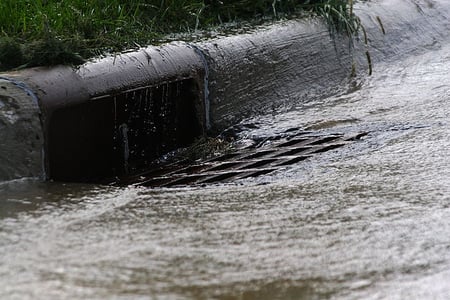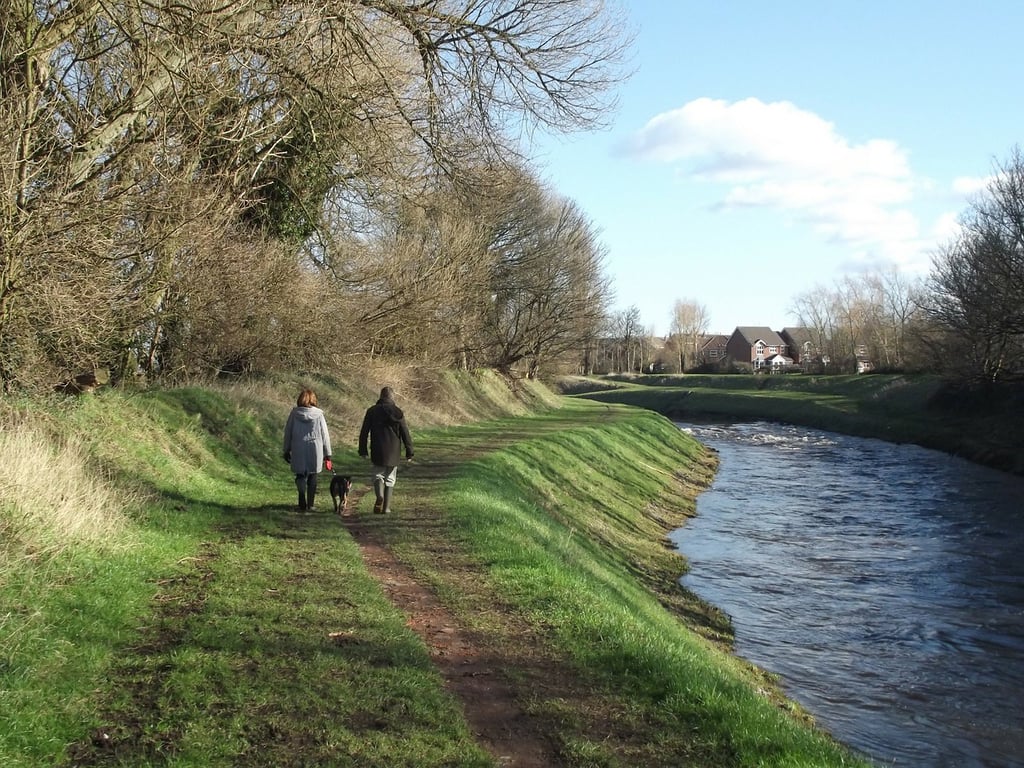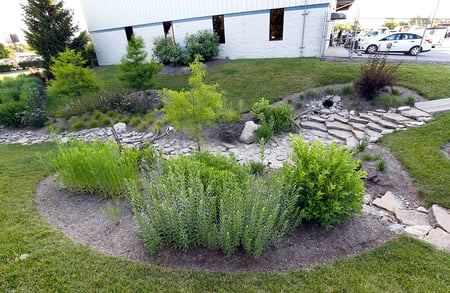Every drop of water that falls from the sky and lands on the ground goes somewhere. It collects on parking lots or pools up in the low-lying areas of our properties. It rushes into drains. It flows into bioswales or retention ponds. Water from rain and snowmelt is referred to as stormwater, and our cities have infrastructure that is supposed to manage it.
The problem is, our infrastructure is in a desperate state. We need to make critical repairs. Because of the expense of doing so, many municipalities have to wait until there is a stormwater system failure before addressing weak links in the infrastructure.
Just how stressed is our water infrastructure?
Water infrastructure needs in the U.S. exceed $100 billion dollars, according to the EPA. And in Lexington, Kentucky, alone, more than $700 million is needed to repair sewer and stormwater systems. (Note: rainwater runoff collects in stormwater sewers and returned to waterways; sanitary sewer water is directed to a water treatment plant.)
The good news is that property owners can do their part to improve the way stormwater runoff is managed on a “micro” level with green infrastructure. Every improvement we make to our commercial properties adds up to a larger positive impact.
So, let’s talk more about the harmful effects of stormwater runoff, and how we can better manage it. We’ll share with you our watershed concept and how taking responsibility for the way stormwater runoff is managed on your property can improve the environment and health of individuals. There are green infrastructure solutions you can implement that suit your budget. Your landscape can do more and contribute to a healthier stormwater system.
The Problem with Stormwater Runoff

When our stormwater management systems are not working properly, we harm the environment and risk the health and safety of our communities. Effective stormwater management is essential for preventing pollutants from entering our waters.
Think about it: Water that rolls over your parking lot collects residual oil from vehicles, waste that has been tossed on the ground, and debris from the environment. All of those “extras” flow along with water into our stormwater systems.
Where does the water go? It is directed back into our lakes, rivers and streams. Then eventually, we usher some of that water into treatment plants to produce the water we use every day, and drink. It’s a cycle, and our stormwater systems are a critical part of making sure the water we return to the environment is not polluted.
However, because of the way we have altered the landscape to meet our modern needs, there is more stormwater runoff. Consider all of the hard surfaces on your property. Parking lots, sidewalks—those impervious surfaces direct water flows into our stormwater sewers.
Nature has its own way of managing stormwater runoff. When rivers flood, for example, that water is slowly absorbed back into the ground. Soil captures and filters out impurities, and sedimentation settles gradually. That sediment-rich soil creates fertile farmland. In fact, the entire ancient Egyptian civilization along the Nile River was sustained by the ability to farm the land following annual floods.
But, we have altered the way nature handles stormwater. For instance, we adjust rivers to prevent flooding. Then, those rivers move faster, and their waters carry more sedimentation that moves downstream rather than being absorbed into soil.
 Stormwater runoff is a problem for several important reasons:
Stormwater runoff is a problem for several important reasons:
- Untreated stormwater that flows into lakes, rivers and streams can contaminate drinking water supplies, burdening our filtration systems.
- Stormwater runoff can harm aquatic life. For example, there is a dead zone in the Gulf of Mexico that’s the size of Massachusetts because of polluted water flowing downstream from the Mississippi River into the Gulf.
- Polluted waters restrict swimming, fishing, boating and other recreational water activities.
- With more impervious surfaces (pavement, cement), we increase flooding and further stress our stormwater sewer systems.
Identifying Stormwater Runoff Concerns On Your Property
It’s easy to identify areas of stormwater runoff concern on your property. Look down. Are you standing on a hard surface? Any area that is an impervious surface is contributing to stormwater runoff in some capacity. When we assess a property to find opportunities to improve stormwater runoff, we look closely at hard surfaces to see how we can redirect and/or slow down water flow.
At Klausing Group, we recognized our own headquarters could improve its stormwater runoff capabilities, too. (Check out our case study to read about the environmental services we put in place.)
Ultimately, we want our properties to act like micro-watersheds. A watershed is the land you’re standing on now. It’s land that “sheds water” into rivers, lakes and streams. Watersheds cover hundreds or thousands of square miles. All of the water that hits the ground eventually finds its way into a natural source.
By treating your property like a miniature watershed and managing the way stormwater runoff flows (the velocity, direction), you can make a positive impact on the environment.
How To Manage Stormwater Runoff
The good news is, there is a range of green infrastructure solutions that improve stormwater runoff. What you choose depends on your property’s requirements and your budget.
Berms and curb cuts: A simple way to redirect water flow across hard surfaces is to install berms that help capture or slow down water. Even speed bumps can redirect water into an area that can handle the velocity, such as lower grades. Adding curb lines or curb cuts to redirect water can also reduce the amount of runoff that flows directly into the stormwater system.
Permeable surfaces: Permeable paving systems (concrete, pavers, etc.) absorb water as it hits the surface. In fact, you can blast a fire hose on the surface and puddles will not form. The surface captures water, which then flows into the surface and soil below it. Remember, soil is nature’s filter.
 Rain gardens: Rain gardens vary from simple spaces that are appropriately landscaped to capture runoff, to more complex ecosystems. Their purpose is to use constructed soils and plants to increase the water percolation rate. That way, water is absorbed into the rain garden; and the area also holds water rather than allowing it to flow straight into the stormwater system.
Rain gardens: Rain gardens vary from simple spaces that are appropriately landscaped to capture runoff, to more complex ecosystems. Their purpose is to use constructed soils and plants to increase the water percolation rate. That way, water is absorbed into the rain garden; and the area also holds water rather than allowing it to flow straight into the stormwater system.
Bioswales: This green infrastructure consists of a swaled drainage course with sloped sides, filled with constructed soils, vegetation and/or riprap. Bioswales are more heavily constructed than rain gardens, and the city or county inspects them to ensure proper functionality. If there are issues, a property owner will receive a notice of non-compliance. We can help property owners address those issues and avoid costly fines.
Water quality units: There are various types of filters that can be installed under the grate where water enters a storm system—or there are stand-alone units like the one we have at Klausing Group. These units include different filtering mechanisms that trap debris and sediment before water enters the storm sewer. The unit can be as simple as a filter basket. The key is to be sure these filters are regularly maintained. They must be emptied, and in some cases replaced.
Many times, property managers do not realize these units exist. So, they might be surprised if the filter units are inspected and found non-compliant by the City of Lexington.
Awareness is the key. Find out if your property has water quality units installed, and maintain (or replace) them so these filters do their job.
Small Efforts Make a Big Difference
Stormwater runoff is a hot-button topic in our country, and for good reason. Our costly infrastructure is aging and deteriorating. In some cases, it is failing completely. More cities are looking for ways to capture water—by planting rain gardens rather than tree wells, and installing curb cuts to redirect water. Small changes are important.
That’s what we want property managers to realize. Small efforts to incorporate green infrastructure on your commercial property can make a positive impact on the environment. It’s not realistic to think you can change everything on your property all at once. Every little bit you do to alleviate some burden from our stormwater systems makes a difference.
Let’s talk more about how you can create a micro-watershed on your commercial landscape. We’d love to share some stories with you so you can understand how green infrastructure works.
Contact us any time in Louisville at 502.264.0127, or in Lexington at 859.254.0762. Or, fill out this simple contact form and we’ll get in touch with you.


